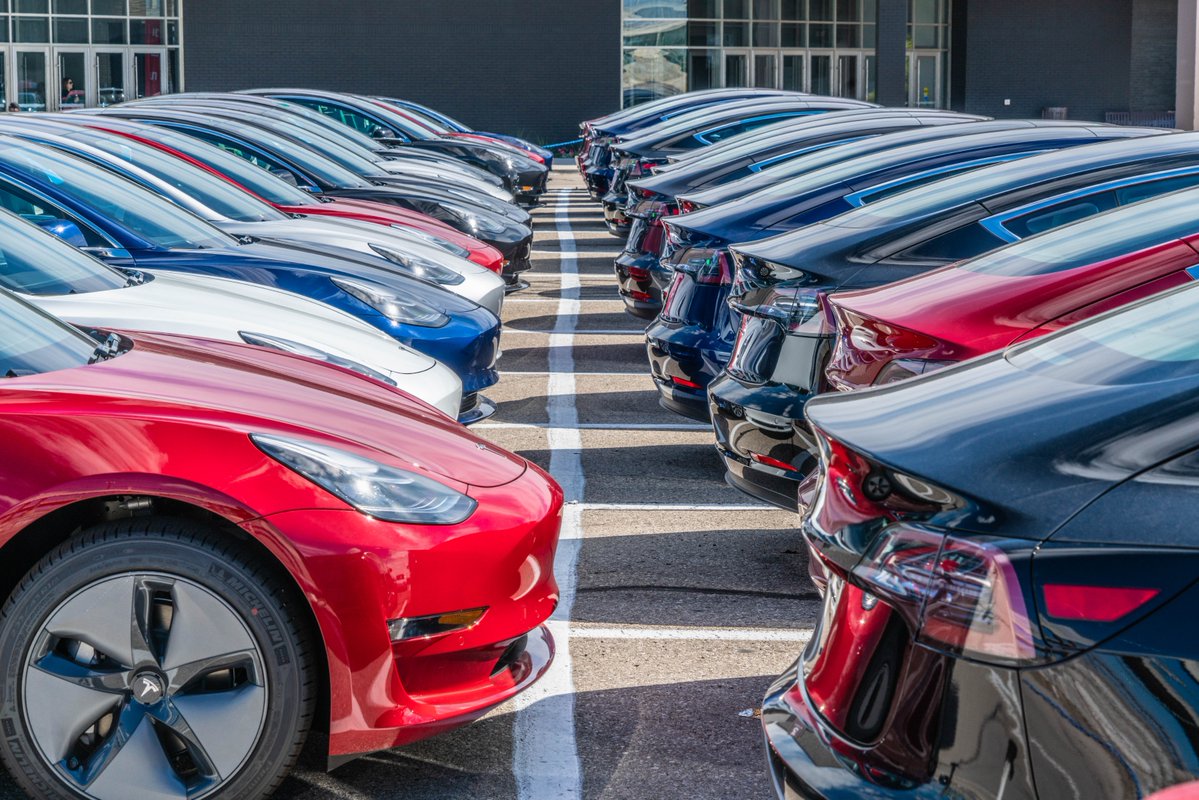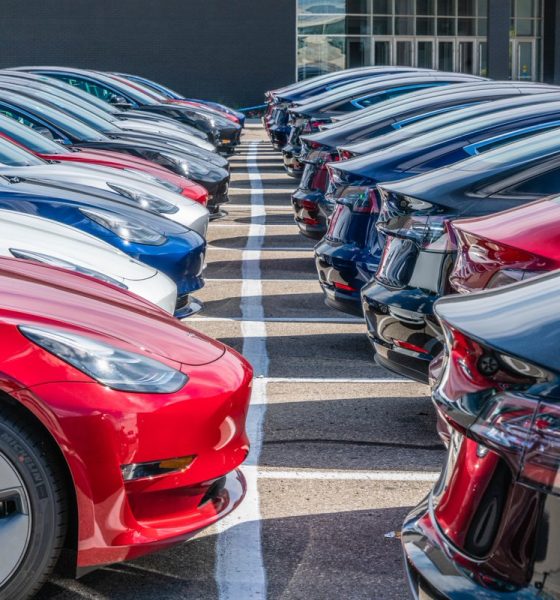

Investor's Corner
Tesla (TSLA) Q2 2019 results: Record cash as Model 3 and China Gigafactory take off
Tesla’s (NASDAQ:TSLA) second-quarter earnings for 2019 saw the electric car maker post a revenue of $6.3 billion, falling short of Wall Street’s estimates. The results, which were discussed at length in an Update Letter, were released after the closing bell on Wednesday, July 24.
Following are the key points in Tesla’s Q2 Update Letter.
Earnings
Tesla reported a net loss of $408 million, translating to a loss of $2.31 per share, a notable improvement from the $3.06 loss the company reported in Q2 2018. In contrast, analysts polled by FactSet expected Tesla to report an adjusted quarterly loss of $0.39 per share. Estimize, a crowdsourced platform that aggregates estimates from analysts, executives, fund managers, and academics, expected Tesla to report an adjusted loss of $0.25 per share.
Revenue
Tesla reported revenue of $6.3 billion for the second quarter, which is also a notable improvement over its figures from Q2 2018, a time when the company showed a revenue of $4 billion. Analysts polled by FactSet expected Tesla to report sales of $6.5 billion in the second quarter, while Estimize placed Tesla at a slightly more optimistic $6.6 billion.
RELATED: LIVE BLOG: Tesla (TSLA) Q2 2019 earnings call updates
Cash Balance
Tesla’s cash balance reached new heights in the second quarter, thanks in part to a capital raise in May. By the end of the second quarter, Tesla had $5 billion in cash and cash equivalents. This is the highest in Tesla’s history to date. “This level of liquidity puts us in a comfortable position as we prepare to launch Model 3 production in China and Model Y production in the US,” the company wrote.
Model 3
The Model 3 has reached a sustained production rate of 7,000 vehicles per week in the second quarter. Tesla is still aiming to hit a production rate of 10,000 Model 3 per week by the end of 2019. Apart from these, the Model 3’s higher-tier variants remain popular among car buyers. “During the quarter, a majority of orders continued to be for a long-range battery option and the Model 3 average selling price (ASP) was stable at approximately $50,000. At the same time, manufacturing costs continued to decline,” Tesla wrote.
Gigafactory 3
Tesla’s Gigafactory 3 in Shanghai is progressing at an incredibly rapid pace. The general assembly building that will host Model 3 and Model Y production is nearing completion, and other structures in the complex, such as a substation, continue to take form. “Gigafactory Shanghai continues to take shape, and in Q2 we started to move machinery into the facility for the first phase of production there. This will be a simplified, more cost-effective version of our Model 3 line with capacity of 150,000 units per year – the second generation of the Model 3 production process,” the electric car maker wrote.
Guidance
Tesla has opted to maintain its guidance of producing a total of 360,000 to 400,000 vehicles in 2019. The company has noted that it is “working to increase our deliveries sequentially and annually, with some expected fluctuations from seasonality.”
Other highlights
- Cash and cash equivalents of $5.0B; Operating cash flow less capex of $614M
- GAAP operating loss of $167M, GAAP net loss of $408M, including $117M of
restructuring and other charges - Auto gross margin at ~19% in spite of reductions in vehicle ASP and lower regulatory
credit revenue - On track to launch Gigafactory Shanghai by end of 2019 and Model Y by fall of 2020
A link to Tesla’s Update Letter for the second quarter could be accessed here.
Join us in our upcoming Live Blog as we join Elon Musk on the second-quarter earnings call.

Investor's Corner
Tesla stock closes at all-time high on heels of Robotaxi progress

Tesla stock (NASDAQ: TSLA) closed at an all-time high on Tuesday, jumping over 3 percent during the day and finishing at $489.88.
The price beats the previous record close, which was $479.86.
Shares have had a crazy year, dipping more than 40 percent from the start of the year. The stock then started to recover once again around late April, when its price started to climb back up from the low $200 level.
This week, Tesla started to climb toward its highest levels ever, as it was revealed on Sunday that the company was testing driverless Robotaxis in Austin. The spike in value pushed the company’s valuation to $1.63 trillion.
Tesla Robotaxi goes driverless as Musk confirms Safety Monitor removal testing
It is the seventh-most valuable company on the market currently, trailing Nvidia, Apple, Alphabet (Google), Microsoft, Amazon, and Meta.
Shares closed up $14.57 today, up over 3 percent.
The stock has gone through a lot this year, as previously mentioned. Shares tumbled in Q1 due to CEO Elon Musk’s involvement with the Department of Government Efficiency (DOGE), which pulled his attention away from his companies and left a major overhang on their valuations.
However, things started to rebound halfway through the year, and as the government started to phase out the $7,500 tax credit, demand spiked as consumers tried to take advantage of it.
Q3 deliveries were the highest in company history, and Tesla responded to the loss of the tax credit with the launch of the Model 3 and Model Y Standard.
Additionally, analysts have announced high expectations this week for the company on Wall Street as Robotaxi continues to be the focus. With autonomy within Tesla’s sights, things are moving in the direction of Robotaxi being a major catalyst for growth on the Street in the coming year.
Elon Musk
Tesla needs to come through on this one Robotaxi metric, analyst says
“We think the key focus from here will be how fast Tesla can scale driverless operations (including if Tesla’s approach to software/hardware allows it to scale significantly faster than competitors, as the company has argued), and on profitability.”

Tesla needs to come through on this one Robotaxi metric, Mark Delaney of Goldman Sachs says.
Tesla is in the process of rolling out its Robotaxi platform to areas outside of Austin and the California Bay Area. It has plans to launch in five additional cities, including Houston, Dallas, Miami, Las Vegas, and Phoenix.
However, the company’s expansion is not what the focus needs to be, according to Delaney. It’s the speed of deployment.
The analyst said:
“We think the key focus from here will be how fast Tesla can scale driverless operations (including if Tesla’s approach to software/hardware allows it to scale significantly faster than competitors, as the company has argued), and on profitability.”
Profitability will come as the Robotaxi fleet expands. Making that money will be dependent on when Tesla can initiate rides in more areas, giving more customers access to the program.
There are some additional things that the company needs to make happen ahead of the major Robotaxi expansion, one of those things is launching driverless rides in Austin, the first city in which it launched the program.
This week, Tesla started testing driverless Robotaxi rides in Austin, as two different Model Y units were spotted with no occupants, a huge step in the company’s plans for the ride-sharing platform.
Tesla Robotaxi goes driverless as Musk confirms Safety Monitor removal testing
CEO Elon Musk has been hoping to remove Safety Monitors from Robotaxis in Austin for several months, first mentioning the plan to have them out by the end of 2025 in September. He confirmed on Sunday that Tesla had officially removed vehicle occupants and started testing truly unsupervised rides.
Although Safety Monitors in Austin have been sitting in the passenger’s seat, they have still had the ability to override things in case of an emergency. After all, the ultimate goal was safety and avoiding any accidents or injuries.
Goldman Sachs reiterated its ‘Neutral’ rating and its $400 price target. Delaney said, “Tesla is making progress with its autonomous technology,” and recent developments make it evident that this is true.
Investor's Corner
Tesla gets bold Robotaxi prediction from Wall Street firm
Last week, Andrew Percoco took over Tesla analysis for Morgan Stanley from Adam Jonas, who covered the stock for years. Percoco seems to be less optimistic and bullish on Tesla shares, while still being fair and balanced in his analysis.

Tesla (NASDAQ: TSLA) received a bold Robotaxi prediction from Morgan Stanley, which anticipates a dramatic increase in the size of the company’s autonomous ride-hailing suite in the coming years.
Last week, Andrew Percoco took over Tesla analysis for Morgan Stanley from Adam Jonas, who covered the stock for years. Percoco seems to be less optimistic and bullish on Tesla shares, while still being fair and balanced in his analysis.
Percoco dug into the Robotaxi fleet and its expansion in the coming years in his latest note, released on Tuesday. The firm expects Tesla to increase the Robotaxi fleet size to 1,000 vehicles in 2026. However, that’s small-scale compared to what they expect from Tesla in a decade.
Tesla expands Robotaxi app access once again, this time on a global scale
By 2035, Morgan Stanley believes there will be one million Robotaxis on the road across multiple cities, a major jump and a considerable fleet size. We assume this means the fleet of vehicles Tesla will operate internally, and not including passenger-owned vehicles that could be added through software updates.
He also listed three specific catalysts that investors should pay attention to, as these will represent the company being on track to achieve its Robotaxi dreams:
- Opening Robotaxi to the public without a Safety Monitor. Timing is unclear, but it appears that Tesla is getting closer by the day.
- Improvement in safety metrics without the Safety Monitor. Tesla’s ability to improve its safety metrics as it scales miles driven without the Safety Monitor is imperative as it looks to scale in new states and cities in 2026.
- Cybercab start of production, targeted for April 2026. Tesla’s Cybercab is a purpose-built vehicle (no steering wheel or pedals, only two seats) that is expected to be produced through its state-of-the-art unboxed manufacturing process, offering further cost reductions and thus accelerating adoption over time.
Robotaxi stands to be one of Tesla’s most significant revenue contributors, especially as the company plans to continue expanding its ride-hailing service across the world in the coming years.
Its current deployment strategy is controlled and conservative to avoid any drastic and potentially program-ruining incidents.
So far, the program, which is active in Austin and the California Bay Area, has been widely successful.








